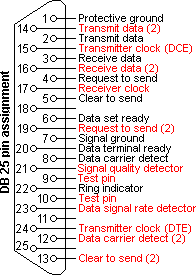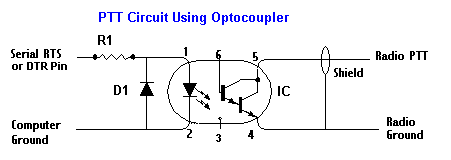PTT (Push to Talk/Transmit) Cable
This page has advice for hams building their own interface.AGWPE will generate the transmit audio, but you also need a way to open the radio's PTT circuit so that the audio can be transmitted. AGWPE and other sound card programs provide for this by sending a signal to a RS232 pin that can activate a simple hardware circuit to open your radio's PTT circuit. AGWPE uses these RS232 pins:
- the serial (COM) port's RTS pin (#7) and
- the parallel (LPT) port's Data Bit 0 and 1 pin (pins #2 and #3)
Note for Windows XP and 2000 users: The parallel port will not work for PTT control in Windows XP or 2000 using AGWPE. Only Windows 95, 98, and ME users can use the parallel port in AGWPE. Windows XP or 2000 users need to use Packet Engine Pro instead of AGWPE if they want to use the LPT port for PTT control.Update: there may be a possible work-around for LPT port use in Windows XP/2000 systems
- Build a cable with an isolated 'gate' circuit that opens the radio's PTT circuit when it receives a signal from the serial or parallel port.Use the cable above with a serial-to-USB port adapter connected to the computer's USB port instead of the serial port.
- Build a TX audio-activated circuit to trigger the PTT, no COM or LPT port needed.
Trying to operate packet using the radio's VOX is likely to be very unsatisfactory because the VOX probably won't key up fast enough. Unlike PSK31, RTTY, MFSK, etc where you key up and stay keyed for extended periods, packet normally uses very short bursts that require that the radio key up fast (i.e. ideally 50-100 ms or less) ...and then un-key fast at the end of the data burst. Even if it did, another problem is the need to guard against room/computer noises if the VOX also opens the microphone. For this reason, experienced sound card users don't use the radio VOX method even for non-packet sound card modes .
A. Building A Cable With An Isolated Gate Circuit
Note: Because a sound card has two audio channels, it is possible to interface two (2) radios to a single sound card. This page describes how to make a cable to control the PTT for a single (1) radio. See the Interfacing 2 Radios to 1 Soundcard page for a dual PTT cable.You may find other variations of the circuit below, most commonly one using a simple transistor (in fact, there's one in the AGWPE 'Help' file). While these circuits will work, they do create a direct ground connection between the computer and radio, and thus create a risk of radio/computer damage in the event of different voltage potentials between the two components. For that reason, I don't recommend them.
Instead, I recommend an isolated 'gate' circuit. Here's a schematic for a single port (one Radio) AGWPE setup which uses a phototransistor (optocoupler) as the gate:
R1 = Resistor, e.g. 1K2, to reduce voltage on the IC pin 1
IC = Integrated Circuit; this sketch shows an IC, such as a 4N33
or PS2603 Optocoupler, which uses a Darlington pair transistor.
(Note: to identify pin #1, look for a small embossed circle on
the top of the IC above pin 1; or looking into the notch in one
side of the IC with the pins down, pin #1 is to the right of the notch.)
D1 = Diode, e.g. IN4001, would shunt any potential reverse voltage
that might damage the sensitive diode/emitter in the IC.
(Note: the band printed on the diode marks the cathode end,
which attaches to the Serial Port/IC Pin 1 line in the sketch above.
The opposite/anode end attaches to Ground.)
The ideal components for your circuit may vary because of your radio's requirements. For example, you might be able to use a different type of IC, such as a 4N25 or PS2601, but that may require a different value for R1.
If you plan to build your own interface, Bux CommCo can provide advice on components for your radio (Bux CommCo components). You might also want to consider a Bux CommCo's RASCAL kit . It will have all the right components for your radio for a good price.
- Other U.S. outlets for parts include , Radio Shack, Digikey, and Newark Electronics.
- Use a cable with a single insulated wire and a braided shield. Attach the shield on each side of the optocoupler to either the radio or computer ground, but do not connect the grounds together.
- If you have a DB9 Serial port (COM), use RTS (Request To Send) pin # 7 for PTT control on a one radio cable. Ground will be pin #5

Do not use the #4 DTR (Data Terminal Ready) pin for single port PTT control despite what the AGWPE Help file or AGWPE web site may say. The DTR pin is used by AGWPE only if you interface a second radio and use AGWPE's Dual Port feature to control PTT on a radio attached to AGWPE port #2. DTR will not be triggered if AGWPE is set to use only a single port/radio.
- If your serial port uses a DB25 COM connection (rarer), use RTS pin 4 for PTT control and pin 7 for ground. Note this is the pin-out for a DB25 serial (COM) port not a DB25parallel (LPT) port.

- If you want to use the parallel port (DB25 LPT) for PTT control instead of the serial port, use LPT pins 2 or 3 for the PTT line and any pin 18 thru 25 for the GROUND.

- Checkhttp://www.cqham.ru/tnc2rad.htm or Buck's packet site for radio pin outs and the location of the PTT pin. (On Buck's site, go to the page for TNC to radio cables and find your radio. Click on the "Add to Cart" button for the cable for your radio and this will reveal a schematic of the radio's pin out information.)
- To test your completed circuit, hook up the cable to your radio and then use a 9 volt battery to simulate the computer signal. Connect the positive + side of the battery to the signal pin in the COM/LPT connector and the negative ― side of the battery to the ground pin in the connector.
- Note on handheld radios: Most handheld radios use the microphone jack to feed both the TX audio signal (AC) and the PTT signal (DC) into the radio. To make sure the TX audio signal (AC) goes into the radio and not back out the PTT line, you will need to include a resistor in the PTT line between the radio's PTT pin (#5 in the schematic above) and the IC. An AC signal will follow the path of least resistance and stay off the PTT line. See your handheld's user manual for the needed resistor values and circuit information. (In addition to the resistor, HTs often require a capacitor on the TX audio line to block DC voltage on the PTT line from getting on to the TX audio line. See the Transmit Audio Cable page on this site.)
- A Special Trick: To make it easy to use either the serial port or printer port, Bill, WB6JAR, came up with this clever design: run a short 2 wire "pigtail" cable from the cable's serial DB9 connector to a parallel DB25 connector.
- Connect the serial's pin 7 (RTS) to the parallel's pin 2 or 3
- Connect the serial's pin 5 (GND) to the parallel's pin 18 or 19-25
B. Serial-to-USB Adapters
It's becoming easier to find a fairly inexpensive serial-to-USB adapters. In fact some computers now come with USB ports but no serial port. If this is your case or if you prefer to make use of the USB port to leave your serial and parallel ports free for non-AGWPE purposes, a serial-to-USB adapter may work for you.To use a serial-to-USB adapter:
- first install the adapter driver
- then go to the Windows Device Manager (Start: Settings; Control Panel: System) and click on the + next to Ports to expand the list and see which COM port the adapter is using
- change your AGWPE Port setting to use the adapter's COM port
- plug your serial port PTT cable into the USB adaptor
| Stephen Smith WA8LMF wrote this in the UI-View Yahoo list about USB-to-Serial adapters:These devices vary wildly in how faithfully they emulate a "real" serial port. This is influenced by both the hardware (chipset that the device is based on) and the software drivers provided. Some are fine for simple three-wire TXD/RXD/COMMON serial hookups (i.e. like connecting a TH-D7) but won't work if the device or software requires handshaking using the RTS/CTS/DTR control lines. Some work for normal serial port data-flow-control usage of the handshake lines, but fail when the handshake lines are used in unusual ways. This includes ham applications such as soundcard interfaces where the handshake lines are set independently of the actual data flow on TXD (for transceiver PTT, RTTY FSK keying, RX squelch detect, CW keying, etc.) The reliability of these devices is also sometimes influenced by the brand of chipset used to implement the USB port inside your computer, and the version and patch level of Windows you are using. All in all, a very hit-and-miss proposition. BOTTOM LINE: You may have to try several different brands or models of these devices (and ALWAYS check for the most recent drivers on the vendor's website -- the drivers on the included CD-ROM are almost certainly several revisions out of date!) to find one that works with your particular version of Windows and with your particular application. There have been consistently favorable comments on multiple ham mailing lists (including this one) about the Edgeport devices. My personal experience is that serial-to-USB cables based on the FDTI chip set and drivers seem to work well. (I've had a USD $15 no-name generic based on the FDTI chipset connecting my D700 to a laptop in the car work flawlessly for over 150,000 KM This includes the last few days in Colorado when the temperature hit -15C... ) The Belkin serial-to-USB devices consistently get complaints. |
I then bought an IOGear adapter (GUC232A) (apparently made by ATEN International Co.) for about $30 US. It works fine on my desktop using Windows XP.
Some users have reported problems with other USB adapters that change COM port assignments with each computer boot-up. It is possible to "freeze" the COM port assignment using the Windows Device Manager (for the Port device use Properties>Port Settings>Advanced).
So, it's possible such an adapter may work on your computer, but you may have to experiment with different brands.
Here some other possible serial-to-SB adapter choices:
- http://pfranc.com/usb/usb.shtml
- http://www.buxcomm.com/ (try search for USB2SC)
C. TX Audio-activated Circuit
It's also possible to open the PTT by using a special circuit that opens the PTT when it "hears" tones on the TX audio line, without any COM, LPT or USB port connection .
Stephen Smith's, WA8LMF, Tone Keyer web page describes how to make such a device. If you need your COM or LPT ports for other devices, you should look into this creative solution.
Another option to avoid using a COM or LPT port is the Tigertronics SignaLink pre-assembled unit which also uses a TX audio tone-activated PTT circuit.
Watchdog Timer: Most TNCs have a timer that prevents continuous transmission in the event of some TNC or software failure. This "watchdog" timer stops transmission that last more than 2 or 3 minutes. With AGWPE's sound card, you don't have such a timer, so here is a page describing how to build a watchdog timer circuit for your PTT cable.


1 comment:
Its help and able to learn something new from it. I like to design new circuit board and cable for it also.
pcb manufacture
Post a Comment